胰岛素泵考核标准
- 格式:doc
- 大小:33.50 KB
- 文档页数:2
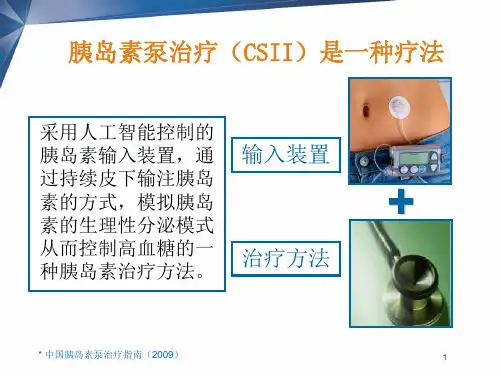
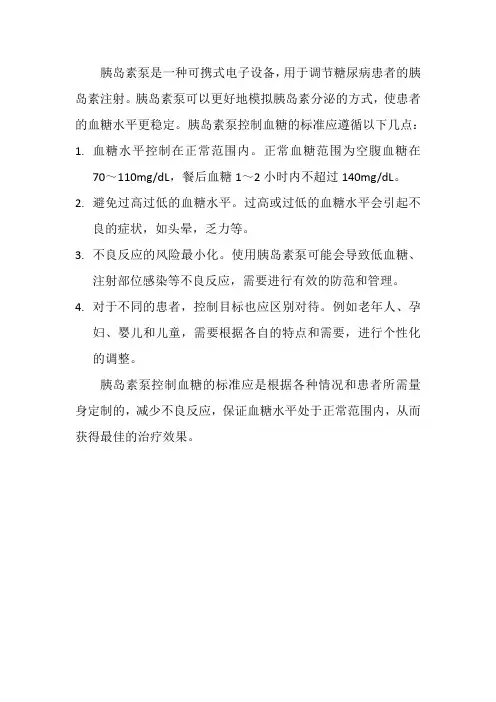
胰岛素泵是一种可携式电子设备,用于调节糖尿病患者的胰岛素注射。
胰岛素泵可以更好地模拟胰岛素分泌的方式,使患者的血糖水平更稳定。
胰岛素泵控制血糖的标准应遵循以下几点:1.血糖水平控制在正常范围内。
正常血糖范围为空腹血糖在
70~110mg/dL,餐后血糖1~2小时内不超过140mg/dL。
2.避免过高过低的血糖水平。
过高或过低的血糖水平会引起不
良的症状,如头晕,乏力等。
3.不良反应的风险最小化。
使用胰岛素泵可能会导致低血糖、
注射部位感染等不良反应,需要进行有效的防范和管理。
4.对于不同的患者,控制目标也应区别对待。
例如老年人、孕
妇、婴儿和儿童,需要根据各自的特点和需要,进行个性化的调整。
胰岛素泵控制血糖的标准应是根据各种情况和患者所需量身定制的,减少不良反应,保证血糖水平处于正常范围内,从而获得最佳的治疗效果。
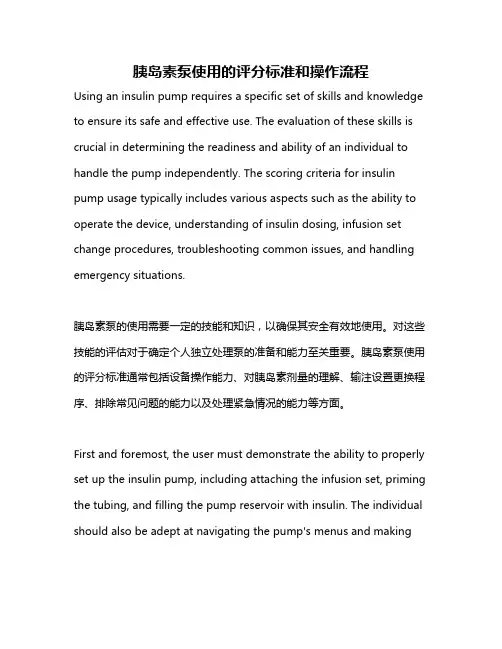
胰岛素泵使用的评分标准和操作流程Using an insulin pump requires a specific set of skills and knowledge to ensure its safe and effective use. The evaluation of these skills is crucial in determining the readiness and ability of an individual to handle the pump independently. The scoring criteria for insulin pump usage typically includes various aspects such as the ability to operate the device, understanding of insulin dosing, infusion set change procedures, troubleshooting common issues, and handling emergency situations.胰岛素泵的使用需要一定的技能和知识,以确保其安全有效地使用。
对这些技能的评估对于确定个人独立处理泵的准备和能力至关重要。
胰岛素泵使用的评分标准通常包括设备操作能力、对胰岛素剂量的理解、输注设置更换程序、排除常见问题的能力以及处理紧急情况的能力等方面。
First and foremost, the user must demonstrate the ability to properly set up the insulin pump, including attaching the infusion set, priming the tubing, and filling the pump reservoir with insulin. The individual should also be adept at navigating the pump's menus and makingadjustments to basal rates, insulin-to-carb ratios, and correction factors as per their healthcare provider's instructions.首先,用户必须展示正确设置胰岛素泵的能力,包括安装输注设置、给管道进行预灌和用胰岛素填充泵储液室。
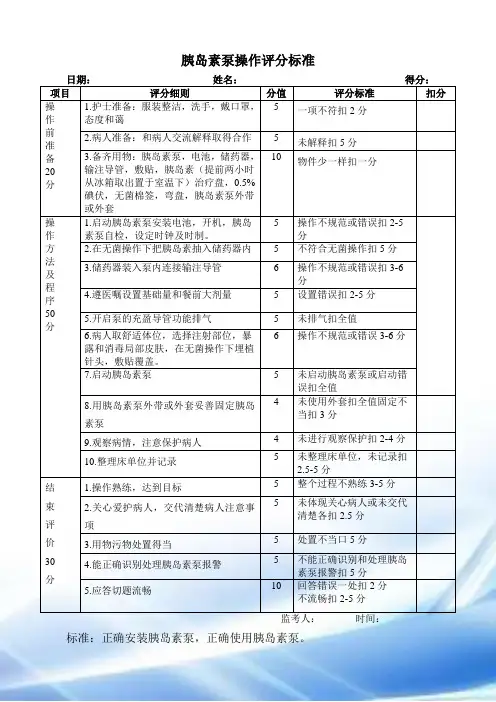
胰岛素泵操作评分标准项目评分细则分值评分标准扣分操作前准备20 分1.护士准备:服装整洁,洗手,戴口罩,态度和蔼5 一项不符扣2分2.病人准备:和病人交流解释取得合作 5 未解释扣5分3.备齐用物:胰岛素泵,电池,储药器,输注导管,敷贴,胰岛素(提前两小时从冰箱取出置于室温下)治疗盘,0.5%碘伏,无菌棉签,弯盘,胰岛素泵外带或外套10 物件少一样扣一分操作方法及程序50 分1.启动胰岛素泵安装电池,开机,胰岛素泵自检,设定时钟及时制。
5 操作不规范或错误扣2-5分2.在无菌操作下把胰岛素抽入储药器内 5 不符合无菌操作扣5分3.储药器装入泵内连接输注导管 6 操作不规范或错误扣3-6分4.遵医嘱设置基础量和餐前大剂量 5 设置错误扣2-5分5.开启泵的充盈导管功能排气 5 未排气扣全值6.病人取舒适体位,选择注射部位,暴露和消毒局部皮肤,在无菌操作下埋植针头,敷贴覆盖。
6 操作不规范或错误3-6分7.启动胰岛素泵 5 未启动胰岛素泵或启动错误扣全值8.用胰岛素泵外带或外套妥善固定胰岛素泵4 未使用外套扣全值固定不当扣3分9.观察病情,注意保护病人 4 未进行观察保护扣2-4分10.整理床单位并记录 5 未整理床单位,未记录扣2.5-5分结束评价30 分1.操作熟练,达到目标 5 整个过程不熟练3-5分2.关心爱护病人,交代清楚病人注意事项5 未体现关心病人或未交代清楚各扣2.5分3.用物污物处置得当 5 处置不当口5分4.能正确识别处理胰岛素泵报警 5 不能正确识别和处理胰岛素泵报警扣5分5.应答切题流畅10 回答错误一处扣2分不流畅扣2-5分标准:正确安装胰岛素泵,正确使用胰岛素泵。
注意事项:1.血糖监测:置泵后头三天监测血糖7次/天,既早中晚三餐前,餐后2小时,晚间10时及凌晨2时的血糖,血糖控制情况改为每日3-4次/天。
置泵3-7天为胰岛素剂量调整期,容易发生低血糖,应加强血糖监测。
2.局部护理:①每天检查输注部位及导管系统2次以上,查看是否有红肿,出血及针头脱出,导管扭曲等,如有感染,应立即更换输注部位和装置,严格执行无菌操作。
![胰岛素泵操作流程及评分标准[1]](https://uimg.taocdn.com/98ff1b0e960590c69fc37683.webp)
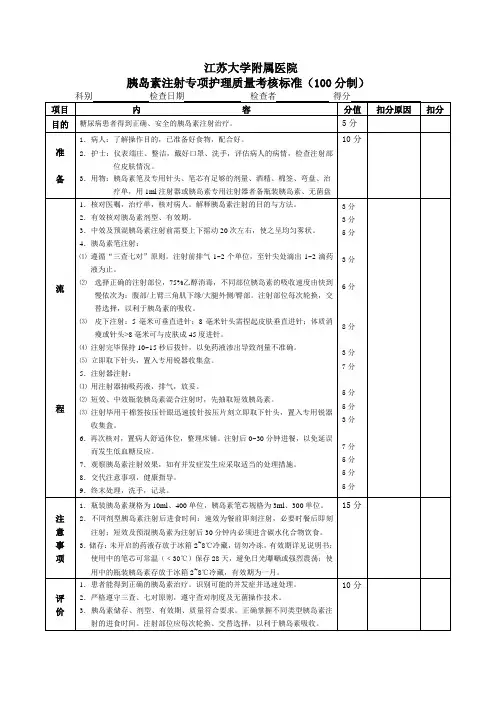
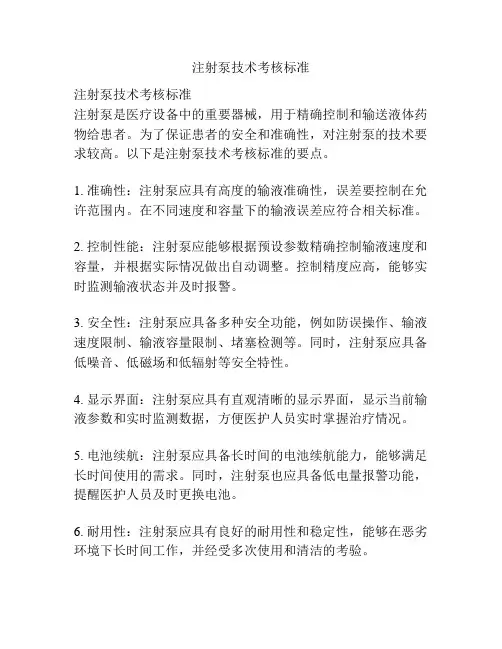
注射泵技术考核标准注射泵技术考核标准注射泵是医疗设备中的重要器械,用于精确控制和输送液体药物给患者。
为了保证患者的安全和准确性,对注射泵的技术要求较高。
以下是注射泵技术考核标准的要点。
1. 准确性:注射泵应具有高度的输液准确性,误差要控制在允许范围内。
在不同速度和容量下的输液误差应符合相关标准。
2. 控制性能:注射泵应能够根据预设参数精确控制输液速度和容量,并根据实际情况做出自动调整。
控制精度应高,能够实时监测输液状态并及时报警。
3. 安全性:注射泵应具备多种安全功能,例如防误操作、输液速度限制、输液容量限制、堵塞检测等。
同时,注射泵应具备低噪音、低磁场和低辐射等安全特性。
4. 显示界面:注射泵应具有直观清晰的显示界面,显示当前输液参数和实时监测数据,方便医护人员实时掌握治疗情况。
5. 电池续航:注射泵应具备长时间的电池续航能力,能够满足长时间使用的需求。
同时,注射泵也应具备低电量报警功能,提醒医护人员及时更换电池。
6. 耐用性:注射泵应具有良好的耐用性和稳定性,能够在恶劣环境下长时间工作,并经受多次使用和清洁的考验。
7. 维护性:注射泵应易于维护和保养,且易于清洁和消毒。
同时,注射泵的零配件易于更换和维修,能够保障设备的长期稳定运行。
8. 用户界面友好性:注射泵的操作界面应简洁明了,按钮和功能设置应符合人体工程学原理,方便医护人员的操作和调节。
9. 兼容性:注射泵应具备与其他医疗设备的兼容性,能够与其他设备无缝连接和协同工作,以提高整体治疗效果。
以上是注射泵技术考核标准的一些要点,注射泵作为医疗器械的一种,对其准确性、控制性能、安全性等方面的要求较高,应严格按照相关标准进行检测和考核,以保障患者的安全和治疗效果。
同时,在注射泵的设计和制造过程中,还应兼顾用户界面友好性和维护性等方面的考量,提高注射泵的易用性和可持续性。
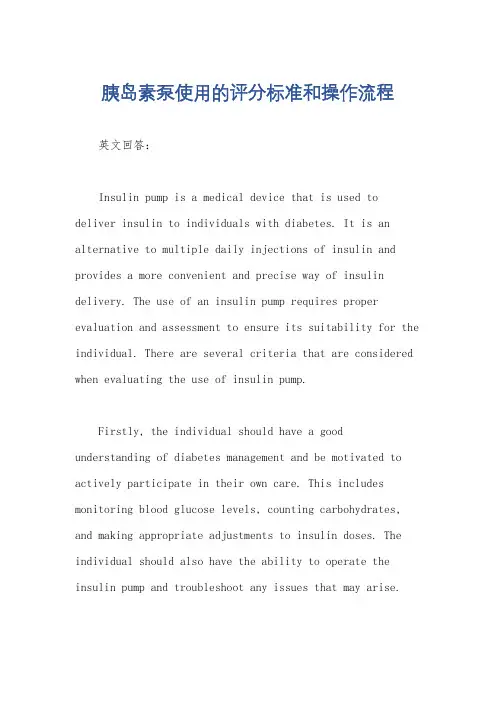
胰岛素泵使用的评分标准和操作流程英文回答:Insulin pump is a medical device that is used todeliver insulin to individuals with diabetes. It is an alternative to multiple daily injections of insulin and provides a more convenient and precise way of insulin delivery. The use of an insulin pump requires proper evaluation and assessment to ensure its suitability for the individual. There are several criteria that are considered when evaluating the use of insulin pump.Firstly, the individual should have a good understanding of diabetes management and be motivated to actively participate in their own care. This includes monitoring blood glucose levels, counting carbohydrates, and making appropriate adjustments to insulin doses. The individual should also have the ability to operate the insulin pump and troubleshoot any issues that may arise.Secondly, the individual should have a stable and predictable lifestyle. This is important because theinsulin pump requires regular monitoring and adjustments to basal rates and bolus doses. If the individual's lifestyle is constantly changing or unpredictable, it may be challenging to maintain proper insulin delivery and control blood glucose levels.Thirdly, the individual should have the support of a healthcare team that is knowledgeable and experienced in insulin pump therapy. This includes healthcare professionals who can provide education and training on the use of the insulin pump, as well as ongoing support and monitoring to ensure optimal glycemic control.Once the individual meets the criteria for insulin pump use, the next step is to initiate the process of obtaining and starting the pump therapy. This typically involves the following steps:1. Consultation with a healthcare professional: The individual will meet with a healthcare professional, suchas an endocrinologist or diabetes nurse educator, to discuss the use of an insulin pump. The healthcare professional will assess the individual's suitability for pump therapy and provide information on the benefits and risks.2. Pump selection and prescription: If the decision is made to proceed with pump therapy, the healthcare professional will help the individual select an appropriate insulin pump based on their needs and preferences. A prescription for the pump will be provided.3. Pump training: The individual will undergo training on how to use the insulin pump. This includes learning how to program the pump, set basal rates and bolus doses, and troubleshoot common issues. The training may be conducted by a diabetes nurse educator or a representative from the pump manufacturer.4. Pump initiation: Once the individual has completed the training and feels comfortable using the pump, theywill start using it on a daily basis. The healthcareprofessional will provide guidance and support during this transition period.5. Ongoing monitoring and adjustments: After starting the pump therapy, the individual will have regular follow-up appointments with their healthcare team to monitor blood glucose levels, review pump data, and make any necessary adjustments to insulin doses. The healthcare team will also provide ongoing education and support to ensure the individual's success with pump therapy.中文回答:胰岛素泵是一种用于给糖尿病患者输送胰岛素的医疗设备。
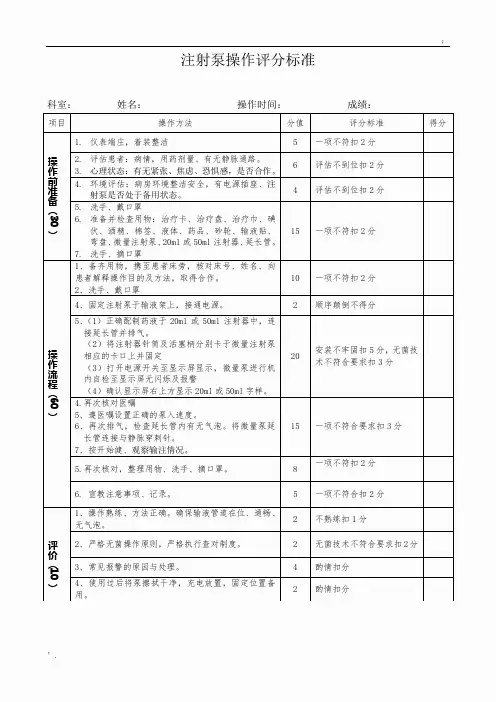
;’. 注射泵操作评分标准科室:姓名:操作时间:成绩:项目操作方法分值评分标准得分操作前准备(30)1.仪表端庄,着装整洁 5 一项不符扣2分2.评估患者:病情,用药剂量、有无静脉通路。
3.心理状态:有无紧张、焦虑、恐惧感,是否合作。
6 评估不到位扣2分4.环境评估:病房环境整洁安全,有电源插座、注射泵是否处于备用状态。
4 评估不到位扣2分5.洗手、戴口罩6.准备并检查用物:治疗卡、治疗盘、治疗巾、碘伏、酒精、棉签、液体、药品、砂轮、输液贴、弯盘、微量注射泵、20ml或50ml注射器、延长管。
7.洗手、摘口罩15 一项不符扣2分操作流程(60)1、备齐用物,携至患者床旁,核对床号、姓名、向患者解释操作目的及方法,取得合作。
2、洗手、戴口罩10 一项不符扣2分4、固定注射泵于输液架上,接通电源。
2 顺序颠倒不得分5、(1)正确配制药液于20ml或50ml注射器中,连接延长管并排气。
(2)将注射器针筒及活塞柄分别卡于微量注射泵相应的卡口上并固定(3)打开电源开关至显示屏显示,微量泵进行机内自检至显示屏无闪烁及报警(4)确认显示屏右上方显示20ml或50ml字样。
20安装不牢固扣5分,无菌技术不符合要求扣3分4.再次核对医嘱5、遵医嘱设置正确的泵入速度。
6、再次排气,检查延长管内有无气泡。
将微量泵延长管连接与静脉穿刺针。
7、按开始健、观察输注情况。
15 一项不符合要求扣3分5.再次核对,整理用物、洗手、摘口罩。
8一项不符扣2分6. 宣教注意事项、记录。
5 一项不符合扣2分评价(10)1、操作熟练、方法正确。
确保输液管道在位、通畅、无气泡。
2 不熟练扣1分2、严格无菌操作原则,严格执行查对制度。
2 无菌技术不符合要求扣2分3、常见报警的原因与处理。
4 酌情扣分4、使用过后将泵擦拭干净,充电放置,固定位置备用。
2 酌情扣分。
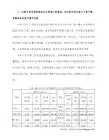
![胰岛素泵操作规范标准[详]](https://uimg.taocdn.com/6652b8eea76e58fafbb0039f.webp)
胰岛素泵护理操作规分泌科胡晶一、胰岛素泵定义持续皮下胰岛素输注(CSII)即胰岛素泵治疗,是采用人工智能控制的胰岛素输入装置,通过持续皮下输注胰岛素的方式,模拟胰岛素的生理性分泌模式,从而控制高血糖的一种胰岛素治疗方法。
胰岛素泵的基本原理胰岛素泵工作原理:生理状态下胰岛素分泌按与进餐的关系可大致分为两部分:一是不依赖于进餐的持续微量分泌,即基础胰岛素分泌,此时胰岛素以间隔8-13min 脉冲形式分泌持续微量输注,模拟人体正常的胰岛素基础分泌规律,主要用于控制夜间、空腹与餐前血糖。
二是由进餐后高血糖刺激引起的大量胰岛素分泌,主要用于控制餐后血糖,模拟人体用餐后胰岛素的快速分泌。
由四部分构成:含有微电子芯片的人工智能控制系统、电池驱动的机械泵系统、储药器、与之相连的输液管和皮下输注装置。
输液管前端可埋入患者的皮下,在工作状态下,泵机械系统接收控制系统的指令,驱动储药器的活塞,最终将胰岛素通过输液管输入皮下。
胰岛素泵的应用现状:在美国已有20年历史.进入中国市场约10年。
目前使用人数已近2万。
据在我国使用胰岛素病患者的调查显示,使用泵的人群中,1型糖尿病(T1DM)为54%,2型糖尿病(T2DM)为44%,其余的2%为其他原因引起的糖尿病。
二、胰岛素泵的适应症1、1型糖尿病患者和需要长期胰岛素强化治疗的T2DM患者,在住院期间可通过胰岛素泵治疗稳定控制血糖缩短住院天数,并优化多次胰岛素注射的方案提供参考数据。
2、需要短期胰岛素治疗控制高血糖的T2DM患者3、糖尿病患者的围手术期血糖控制4、应激性高血糖患者的血糖控制5、妊娠糖尿病或糖尿病合并妊娠三、胰岛素泵的特点1.更有利于血糖控制①平稳降糖,减少波动:胰岛素泵可根据患者的血糖情况灵活的调整餐前大剂量与基础输注量,有效地控制餐后高血糖和黎明现象,降低糖化血红蛋白(HbA1c)水平。
②减少体重增加:胰岛素泵可以减少胰岛素用量,避免过大剂量使用胰岛素导致的体重增加。
胰岛素泵的使用流程科室: 姓名: 得分: 项 目要 求分数 扣分原因评估(5分) 1、病人病情、血糖值。
1 2、核对注射单与医嘱:床号、姓名、住院号、胰岛素剂型、剂量、时间、用法。
1 3、病人对胰岛素泵治疗了解程度。
1 4、注射部位皮肤有无硬结、破损。
1 5、食物准备情况。
1 准备(5分)1、护士:洗手、戴口罩,向病人做好解释工作。
1 2、环境:清洁、安静。
13、用物:治疗盘内备胰岛素泵、泵用电池、储药器、针尖、专用导管、3M 透明贴、超短效胰岛素、75%酒精、棉签、弯盘、胰岛素泵血糖监测单、胰岛素泵巡视单。
3流程(80分)装药(30) 1、检查泵的清洁度、性能,检查电池电量,安装泵电池 2 2、检查管路和储药器的质量及有效期。
2 3、检查胰岛素种类及有效期,检查胰岛素性能,瓶身有无破裂,药液有无变质。
复温胰岛素。
3 4、取出注射器,把针头安装在注射器上,把活塞推杆旋紧。
3 5、胰岛素瓶朝上,缓慢抽吸胰岛素,清除注射器内的空气及气泡,卸下针头。
3 6、把旋帽压在注射器上,逆时针旋转,卸下活塞推杆。
3 7、检查电机是否回退到位。
3 8、安装药液,检查接口是否旋紧3 9、排气,检查有无气泡。
3 10、按医嘱设置并检查餐前量、基础量和时钟。
双人核对。
5 装泵(30)1、 再次核对病人床号、姓名、胰岛素的种类、剂量、性质、有效期。
32、暴露注射部位:常取腹部,耻骨联合以上约1cm ,最低肋缘以下约1cm ,脐周2.5cm 以外的双侧。
(男性患者一般选择上腹部注射、女性患者选择下腹部注射)。
53、75%酒精局部消毒两次,自然待干。
3 4、捏起注射部位皮肤,将针尖以90°迅速插入皮下,以注射点为中心贴好胶布,标注装泵时间及执行者。
5 5、将胰岛素泵放入皮套或透明套挂在病人皮带上或放置在口袋内。
3 6、向病人交代胰岛素泵使用过程中的注意事项。
5考核者签名:考核时间:年月日。
微量注射泵操作考核标准微量注射泵操作考核标准微量注射泵是一种专用的医疗设备,用于定量输液,操作的准确性和安全性非常重要。
以下是微量注射泵操作的考核标准。
1. 操作准备a. 确认所使用的微量注射泵是否完好无损,检查电源是否正常接通。
b. 熟悉微量注射泵的各个部位和功能,明确各个按键和指示灯的作用。
c. 准备所需的输液器、输液管、针头等器材。
2. 调整输液速度a. 根据医嘱设定输液速度,选择合适的输液模式(滴定模式或流速模式)。
b. 使用按键或旋钮,逐级调整输液速度,确保输液速度符合医嘱要求。
3. 设置输液总量a. 根据医嘱设定输液总量,使用按键或旋钮进行设置。
b. 监测输液容器中的液位,确保输液总量设定正确。
4. 警报处理a. 当出现输液泵故障、输液速度异常等情况时,会发出警报声音或显示警报信息。
b. 必须及时处理警报,根据警报信息进行相应的操作,如检查输液管路是否阻塞、重新调整输液速度等。
5. 输液监测a. 定期检查输液泵的工作状态,确保泵的运行正常。
b. 监测输液速度和输液总量,及时调整和记录。
6. 安全操作a. 在操作过程中,保持环境整洁清洁,避免污染。
b. 输液过程中,密切监测患者的情况,及时发现异常反应。
c. 严格按照消毒和无菌操作规范,使用器材前必须进行消毒处理。
7. 灵活应对突发情况a. 当输液泵故障或电源中断等突发情况发生时,要能够迅速采取相应措施,如切换到手工输液等。
8. 培训和培养意识a. 不断学习和提升微量注射泵操作的技能,积极参加培训和考核。
b. 配合医疗中心的培养计划,进行定期的技能培训和操作考核。
以上是微量注射泵操作考核的标准,通过对操作人员的考核,可以确保微量注射泵的安全和准确性,保障患者的输液质量和治疗效果。
精品资料
胰岛素泵考核标准
........................................
安徽省糖尿病专科护士培训基地
胰岛素泵操作评分标准
姓名:工作单位:
得分:
监考人:
时间:
注+意事项:
1、血糖监测:置泵后头三天监测血糖7次/d,即早中晚三餐前、三餐后2h及凌晨2时的血糖,第4天起视血糖控制情况改为每日3~4次,尤其是置泵后3~7天为胰岛素剂量调整期,容易发生低血糖,所以要加强血糖监测。
2、局部皮肤护理:
①输注导管在皮下保留3~5天(冬季可适当延长至5 ~7天),更换一次输注部位和导管系统。
新注射部位与原注射部位应相隔2~3cm以上,原注射针眼处用碘酊或碘伏消毒
②每天检查输注部位及导管系统2次以上,查看是否有红肿,出血及针头脱出、导管扭曲等,如有感染,应立即更换输注部位和装置,严格执行无菌技术操作。
3、严防输注装置阻塞处理。
4、对患者做好携泵指导:
①妥善放置胰岛素泵,洗澡时可使用快速分离器将泵脱开,但不应>1h,沐浴完毕应立即装上。
淋浴时间短可不取泵,用塑料袋将泵装好挂在脖子上即
可,避免将泵摔至地上或沉入水底,也不应将泵置于气温>45。
C或 <1.5 。
C的环境中,防止胰岛素失效。
②特殊检查时应注意避免将泵直接置于X线下,如患者需行CT、核磁共振及其他放射性检查时,应使用快速分离器将泵取下,检查完后再接上。
胰岛素泵持续皮下注射技术操作评分标准(50分制)姓名:科室:日期:评分:监考人:操作项目操作内容分值扣分操作目的通过模拟胰岛素的生理分泌模式,用持续皮下输注胰岛素的方式控制高血糖。
评估要点1、评估患者的病情、意识状态、合作程度及注射部位皮肤情况。
2、胰岛素泵的功能、胰岛素剂型剂量,患者的进餐情况。
护士准备:着装整洁规范,仪表端庄大方。
2操作准备操作用物:注射盘:碘伏、棉签、弯盘、胰岛素泵及输注材料一套,透明敷帖1张,注射单及药液。
31)核对医嘱,检查胰岛素泵的性能,安装药液并排气呈备用状态,备透明敷贴。
32)核对床号、姓名、住院号,评估患者。
33)洗手,戴口罩。
携用物至床旁,再次核对。
54)取舒适体位。
2 5)开机,再次核对。
36)设置时间与当前时间一致。
57)遵医嘱设置基础率,并检核基础率是否正确。
58)碘伏消毒皮肤。
3 9)再次核对,选择好穿刺部位进行穿刺,并固定针头。
210)询问需要,整理床单位,协助取舒适体位。
211)处理用物。
洗手,取口罩。
212)医生开具的临时医嘱操作完毕后执行者签名、签时间。
3操作步骤13)操作速度:完成时间限10分钟以内。
2 综合评价A、5分;B、4分;C、3分;D、2分;E、1分;F、0分; 5指导要点1、带泵期间如外出行磁共振和CT检查时,一定要下泵。
胰岛素泵不防水,洗澡时要下泵。
2、告知患者输注餐前大剂量后进餐的时间,低血糖的症状及处理方法。
注意事项1、正确选择输注部位。
首选腹部(肚脐5㎝以外),避免系皮带的部位。
2、观察穿刺部位有无红肿疼痛。
3、观察有无低血糖反应。
评分标准(1)按操作程序各项实际分值评分。
(2)原则性操作程序颠倒一处扣2分。
安徽省糖尿病专科护士培训基地
胰岛素泵操作评分标准
姓名:工作单位:得分:
注+意事项:
1、血糖监测:置泵后头三天监测血糖7次/d,即早中晚三餐前、三餐后2h 及凌晨2时的血糖,第4天起视血糖控制情况改为每日3~4次,尤其是置泵后3~7天为胰岛素剂量调整期,容易发生低血糖,所以要加强血糖监测。
2、局部皮肤护理:
①输注导管在皮下保留3~5天(冬季可适当延长至5 ~7天),更换一次输注部位和导管系统。
新注射部位与原注射部位应相隔2~3cm以上,原注射针眼处用碘酊或碘伏消毒
②每天检查输注部位及导管系统2次以上,查看是否有红肿,出血及针头脱出、导管扭曲等,如有感染,应立即更换输注部位和装置,严格执行无菌技术操作。
3、严防输注装置阻塞处理。
4、对患者做好携泵指导:
①妥善放置胰岛素泵,洗澡时可使用快速分离器将泵脱开,但不应>1h,沐浴完毕应立即装上。
淋浴时间短可不取泵,用塑料袋将泵装好挂在脖子上即可,避免将泵摔至地上或沉入水底,也不应将泵置于气温>45。
C或 <1.5 。
C的环境中,防止胰岛素失效。
②特殊检查时应注意避免将泵直接置于X线下,如患者需行CT、核磁共振及其他放射性检查时,应使用快速分离器将泵取下,检查完后再接上。